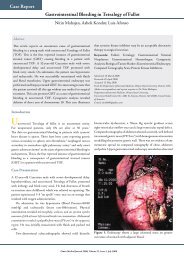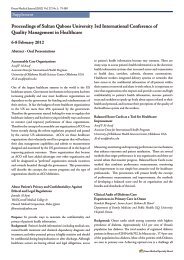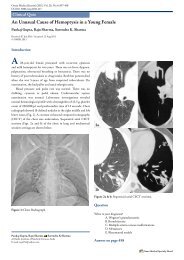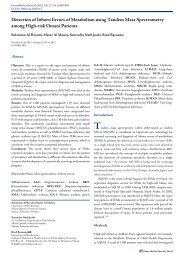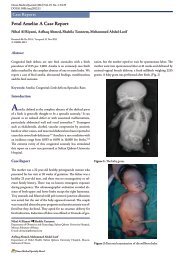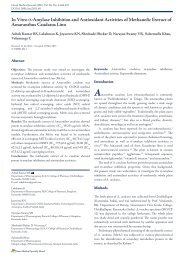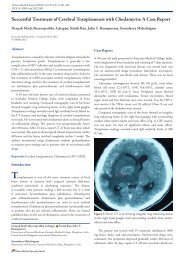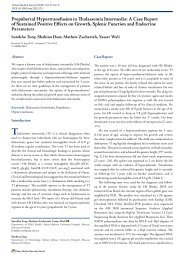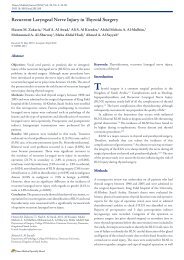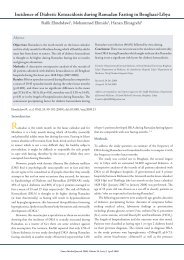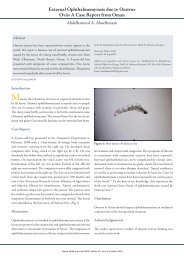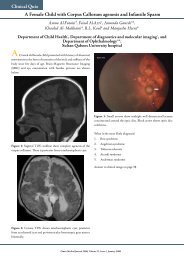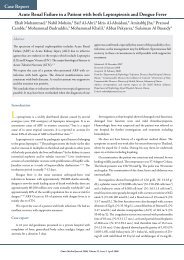instructions to authors - OMJ
instructions to authors - OMJ
instructions to authors - OMJ
You also want an ePaper? Increase the reach of your titles
YUMPU automatically turns print PDFs into web optimized ePapers that Google loves.
Instructions <strong>to</strong> Authors<br />
SUBMISSION OF MANUSCRIPTS<br />
Manuscripts should be submitted online (http://www.omjournal.org), but if you have difficulty with online submission you may mail us<br />
an electronic copy of the manuscripts on floppy disk or CD. To ensure that peer review is double-blinded, there should be no title page in<br />
the file of the manuscript that is submitted online. The file name should not include the author’s name or other identifying text. Portions<br />
of the submission (pho<strong>to</strong>graphs, artwork, etc.) may be sent by mail if necessary, but we prefer that these be prepared in digital form and<br />
submitted online. If you have difficulty, contact us by e-mail at omj2007@gmail.com.<br />
MANUSCRIPT PREPARATION<br />
The format of the Oman Medical Journal complies with “Uniform Requirements for Manuscripts Submitted <strong>to</strong> Biomedical Journals”<br />
published by the International Committee of Medical Journal Edi<strong>to</strong>rs (see http://www.icmje.org). We encourage the use of reporting<br />
guidelines such the CONSORT statement for randomized, controlled trials and the STROBE statement for observational studies<br />
(see http://www.equa<strong>to</strong>r-network.org/). Manuscripts, including tables, references, and figure legends, must be prepared using a word<br />
processing program and submitted online (http://www.edi<strong>to</strong>rialmanager.com/omj). Before submitting a manuscripts, create an account<br />
on the Edi<strong>to</strong>rial Manager website.<br />
We publish edi<strong>to</strong>rials, original articles, review articles, case reports, brief communications, clinical quizzes and letters <strong>to</strong> the edi<strong>to</strong>r.<br />
Manuscripts should be produced <strong>to</strong> fit A4 paper, with approximately 3-cm margin on all sides. The length should not exceed 30 pages<br />
(double spaced and single sided), less for case reports and book reviews. Use the Times New Roman font, 12 point in Microsoft Word.<br />
Use minimum formatting, since most formatting will be removed before typesetting. Restrict formatting <strong>to</strong> superscripts and what<br />
is absolutely essential <strong>to</strong> reveal various heading levels. All manuscripts must be accompanied by a covering letter, signed by all the<br />
<strong>authors</strong>.<br />
Title Page. This must contain only (a) The title of the paper, (b) The full names of all the <strong>authors</strong> and (c) Their affiliations and addresses,<br />
including the email address of the corresponding author.<br />
Abstract. All original articles must contain a structured abstract of not more than 250 words. Usually, the abstract should be divided in<strong>to</strong>:<br />
Objectives, Methods, Results, and Conclusion.<br />
Manuscript Format. Most Original Articles have the following format: Introduction (the question the paper intends <strong>to</strong> answer, what<br />
remains unknown, how patients could benefit from the answer); Methods (study design and methods, operational definitions of major<br />
variables, description of the patients or subject population, and labora<strong>to</strong>ry and statistical methods); Results (pertinent findings in a<br />
logical sequence with tables and figures as necessary); and Discussion (conclusion based on the findings, evidence from the literature<br />
that supports the conclusions, conflicting evidence, applicability of the conclusions, limitations of the study, and implications for future<br />
research or clinical applications).<br />
References. List references in consecutive numerical order (the order of citation in the manuscript, and not alphabetically). Once a reference<br />
is cited, all subsequent citation should be <strong>to</strong> the original number. All references must be cited in the text or tables. References <strong>to</strong> material<br />
on the Internet should include the date of access. Manuscripts with incorrectly formatted citations will be returned <strong>to</strong> the author for<br />
correction. The author is responsible for the accuracy and completeness of the references and for their correct textual citation. In-text<br />
reference numbers should be in superscript and place after the period or comma (not in parentheses), as at the end of this sentence. 1<br />
Within a reference list all <strong>authors</strong> up <strong>to</strong> a maximum of six. If there are more than 6 <strong>authors</strong> then write “et al.” after the sixth author.<br />
Please adopt the exact style as shown in the examples below, including punctuation and abbreviations of journal names, which should be<br />
as per Index Medicus (see Journals Database section in PubMed)<br />
Journal Citation (Omit month and issue number. List all authrs, but if the number is more than six, write “et al.” after the sixth author)<br />
Heindenreich C, Lye P, Simpson D, Lourich M. The search for effective and efficient ambula<strong>to</strong>ry teaching methods through the literature.<br />
Pediatrics 2000; 105:231-237.<br />
Oman Medical Journal 2008, Volume 23, Issue 2, April 2008
Instructions <strong>to</strong> Authors<br />
Book Chapter<br />
S.M. Breathnach. Drug Reaction. In Rook et al. Text Book of Derma<strong>to</strong>logy. 7 th Edition. London, 2004. p.73.1-73.180, 74.1-74.20.<br />
Book<br />
Dewey J. The Quest for Certainty. New York: Min<strong>to</strong>n, 1929.<br />
Report<br />
1. Ministry of Health, Oman. Annual Health Report 2007, Direc<strong>to</strong>rate General of Planning, Department of Information and Statistics,<br />
2008.<br />
2. Akutsu T. Total heart replacement device. Bethesda, MD: National Institute of Health, national Heart and Lung Institute; 1974 Apr.<br />
Report no: NIH-NHLI-69-2185-4<br />
Online sources<br />
1. Onlien book or website<br />
Tardiff A, Harvey P, Cole III, Ralph E, et al. Dacryocele. Available at: www.fetus.net. Accessed May 30, 2006.<br />
2. Online journal article:<br />
Miyamot<strong>to</strong> O, Auer RN. Hypoxia, ischemia and brain necrosis. Neurology [serial online] 2000; 54:362-271. Available at: www.<br />
Neurology.org. Accessed April 18, 2006.<br />
3. Others:<br />
Pregnancy after 35. From www.marchoftimes.com. Accessed Sept 2004.<br />
Units of Measurement. With the exception of blood pressure, all units of measurement and labora<strong>to</strong>ry values must be expressed in SI<br />
units; conventional units may be included parenthetically.<br />
Illustrations. Pho<strong>to</strong>graphs, scientific graphs and other illustration should be uploaded as separate files, not embedded in Microsoft Word.<br />
The format should be .TIF or .EPS at 300 dpi (dots per inch) or greater resolution (please see http://www.pubmedcentral.nih.gov/about/<br />
image_quality_table.html). File saving option can be found in most software in the ‘Save As’ or ‘Export’ commands under the ‘File’ menu.<br />
Save original files in the event that submitted files are not suitable for publication. Graphs must be digitally scanned, if not prepared<br />
initially as an electronic file in a scientific graphing program. Simple line and bar charts are usually sufficient. Avoid 3D charts. The<br />
resolution of images prepared in Microsoft Powerpoint (72dpi) is not usually sufficient for print publication. Subjects in pictures should<br />
not be identifiable. Written permission must accompany any illustration that has been previously published. All illustration must be<br />
numbered as cited in the text in consecutive numeric order. For pho<strong>to</strong>micrographs, the legend should include the original magnification<br />
and stain used.<br />
Tables. Tables should be prepared using the table function in Microsoft Word or other software. Verify tabular statistics <strong>to</strong> make sure<br />
they tally and match data cited in the text.<br />
Oman Medical Journal 2008, Volume 23, Issue 2, April 2008



